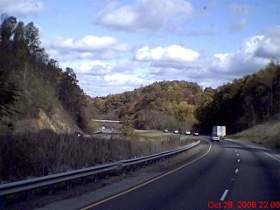Running Against The Governor - Another Form Of Engine Braking - How Does It Work Exactly?
Topic 7728 | Page 2

Well if you have Auto engine brake like my Cascadia, and you set the speed control (cruise) to what speed you like, if you top a hill and speed up, the Auto engine brake will kick in. (assuming the system is turned on) Still need to watch for wet/icy conditions. So I think they mean it's not running up against a Governor but up against a preset speed where the engine brake automatically kicks in.
I've stayed away from the engine brake unless the roads are dry. Period. I don't use it when it's raining, snowing, or during any kind of precipitation that would make the roads wet. I don't use it if it is not precipitating, but the roads are still wet. Am I being overcautious? Curious about what you and some other experienced drivers do on here.
Ok, this is being filed under "advanced braking techniques". If you're new to trucking your safest bet it to try to avoid using Jakes on anything other than dry roads or use this method very conservatively.
As was mentioned above, the Jakes only apply braking force to the drives while the foot brake applies braking force to every axle. If you are on wet roads you can use the two together. Start off by having your foot on the foot brake and then kick the Jakes on. If you have a switch on your Jakes that gives you different power levels then start it in one of the lower power settings. If you have nothing but an on/off switch for your Jakes then keep the RPM's on the low side which will have a similar effect. The higher your RPM's the more force the Jake Brake applies.
By having your foot on the brake and then kicking the Jakes on at a lower level you will balance out the braking force across all of the axles far better than using the Jakes alone. But do not kick on the Jake Brake unless your foot brake is already being applied strong enough to feel it. You want all of your axles applying the brakes with the foot brake before kicking on the Jakes. If you kick on the Jakes first, all of the braking force is going straight to your drives and you greatly increase your chances of a jackknife.
Let me make some bullet points to sum this up clearly:
On wet roads:
1) Apply the footbrake strong enough that you can feel it holding you back
2) Set your jake brake switch to a lower setting and start with your RPM's on the lower end - say below 1300.
3) Kick on your Jake Brake while still applying force with the foot brake.
4) When you're ready to release your brakes turn off the Jake brake while still applying force with the foot brake.
5) Release the foot brake.
So on slick roads you never want the Jake Brake on by itself. You want to apply the footbrake before applying the Jake Brake and you want to release the Jake Brake before releasing the footbrake.
Hope this helps.
OWI:
Operating While Intoxicated
I"m wondering what the heck some of these drivers are referring to then, when they talk about running against the governor as a sort of engine brake?
You have a lot of old school drivers at your company. Back in the day there were no Jake Brakes and even years after they came out most trucks didn't have them. So the only other option you really had to help slow the truck was to put it in a lower gear, let the engine wind up as high as you could safely let it, and let the engine's compression hold you back a little. Honestly it doesn't do a whole lot. It helps and it's certainly better than nothing, but it's almost nothing compared with today's modern Jakes of course.

Thanks Brett. It's become more clear to me now. I appreciate the details on using the engine brake with the foot pedal. I just wanted to see if there was another braking technique available that I might have been missing, when the roads are too slick to safely use the engine brake by itself. 5-3 technique seems to be the other only option besides exclusively using the engine brake, unless you utilize that hybrid approach that you described.
We have a run that goes out to western PA where you have to tackle a 9% and 11% grade. I've already ran it a few times, but always had the fortune of dry roads so I used the engine brake on high in 6th gear. Never had to use the foot pedal to brake, not even once. Just trying to prepare myself to descend this grade when I can't use the engine brake. Truck speed limit is 20 mph, if I recall, it might be 25 mph. So I assume that 6th gear would be a good starting gear, and then just incorporate the 5-3 technique, while establishing 15-20 mph as my safe max speed - to be conservative. It's not a straight shot. There are hairpin curves and no guard rail. Similar to stuff I've seen out west like CA. If the roads are slick, I might even drop it below 5th and just crawl down.
New Reply:
New! Check out our help videos for a better understanding of our forum features

















Preview:








 TT On Facebook
TT On Facebook
I"m wondering what the heck some of these drivers are referring to then, when they talk about running against the governor as a sort of engine brake?